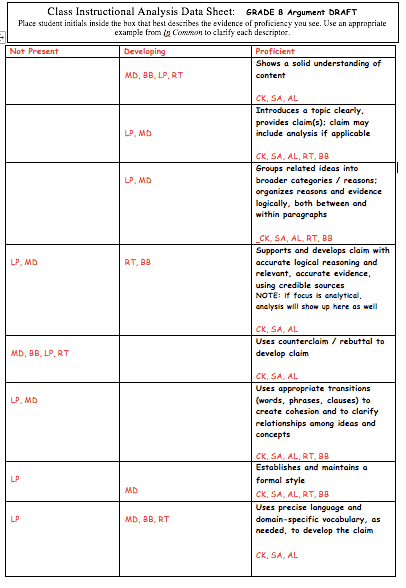Remember Theresa?
Theresa is the middle school humanities teacher whose students have been studying World War One. After several weeks of immersion into the disaster of that war, they grappled (as senators did in 1919) with whether or not the best way to prevent another such world war was for the United States to join the newly formed League of Nations.
Theresa’s hope for her students was clear to her – that they would be able to show their grasp of the complexity of this huge historical and complicated issue by making a reasonable claim about joining the League, then developing that claim with reasons and accurate historical evidence. In other words, a proficient and effective piece of argument writing.
To get a good handle on this for herself as their teacher, Theresa had used an Instructional Analysis checklist for 8th grade argument writing.
Let’s take a look at that checklist, below.
 Theresa has carefully analyzed her 32 student essays, using her benchmark for “proficient” for this argument essay, and the checklist, to record what she was seeing. Comparing their writing against that benchmark, Theresa has noted what each student did in terms of each criterion for solid, content-based argument writing – were they proficient? Were they developing? Was there no real evidence at all?
Theresa has carefully analyzed her 32 student essays, using her benchmark for “proficient” for this argument essay, and the checklist, to record what she was seeing. Comparing their writing against that benchmark, Theresa has noted what each student did in terms of each criterion for solid, content-based argument writing – were they proficient? Were they developing? Was there no real evidence at all?
To do that recording, Theresa used each student’s initials, recorded in the appropriate column. (Note that for our purposes, we are looking only at 7 of Theresa’s students.)
Now, comes the real learning for Theresa:
- What patterns is she seeing in this work?
- What can her students do well?
- What can they not yet do well?
Analyzing the patterns
Let’s step inside Theresa’s head for a moment as she learns from her students:
“Well, it’s pretty easy to see that three of these kids (CK, SA, and AL) have a good grasp of this content – they all showed solid understanding (for 8th graders) of this complicated issue. It’s so interesting…..they did not all make the same claim about whether or not it was a good idea to join the League of Nations, but they did all make a reasonable claim – so that’s good.
Really, these three kids were proficient in every aspect of this task, even working with an accurate counterclaim and then rebutting it to support their own claim. I was worried about that – I know how hard that kind of thinking is for kids to do – so I’m glad to see that some of my kids got it! In fact, some of them got it so well that I think they may be ready for more of a challenge next time – I’ll need to give that some thought.
Hmm……let me look a bit more closely. It looks like most of the kids were able to make a reasonable claim about joining the League (or not), and then organize their reasons and evidence pretty well – that’s great.
On the other hand, most of the class could not handle the counterclaim thinking at all – oh, dear…I do know that kind of thinking is hard, and I thought I taught into it pretty well…..I had the kids debate the issue, after all….but clearly, for most kids, that wasn’t enough.
So, that meant that those same kids didn’t really show the solid understanding of the issue that I was after – if you can’t think about all those folks who disagree with you, then you don’t have a deep enough understanding of the whole issue – after all, “understanding” is more than knowing what you yourself think! Well, that’s good information for me….I’ll have to do more with that on our next argument piece.
Let me look at how my struggling kids did here. I always worry about LP – reading is so hard for her. It’s probably because of that reading struggle that LP has a fairly limited grasp of the whole topic in this essay – look at how general and even vague her language is when she tries to give evidence.
On the other hand, she did try to make a reasonable claim, and she tried to organize the reasons and evidence – so that makes me realize that if I pay more attention, next time, to making sure she gets support with reading the text, she’ll probably be able to do a lot better job with her writing!”
Next Steps
Based on her thoughtful analysis of the patterns that emerged on the Instructional Analysis checklist, Theresa was able to figure out some instructional moves (for the next essay) that she was pretty sure would help her kids. Some of these included:
Providing for her strongest students
For some students, “proficient” was easily attainable. Theresa knew they could benefit from an additional, more challenging text that they could read more independently. Perhaps she would also ask them to develop their claim more fully, with more reasons and evidence – they seemed ready for that.
Paying more attention to building strong content knowledge
Theresa could see that some students did not understand this League of Nations issue well enough to develop their claim adequately with reasons and evidence. This was a good wake-up call for Theresa: spend enough time developing the content knowledge before writing!
Giving all students more oral practice with counterclaim and rebuttal
Theresa knew that, as 8th graders, this was not a kind of thinking and writing they were deeply familiar with. She could now see that her students needed more oral practice with this, so that they would be able to do the careful reasoning that “counterclaim and rebuttal” require.
Spending more time with models
Theresa had used a full argument model in instruction but she realized that she might also give her kids more written examples – models, really – specifically of good counterclaim thinking/writing. Everyone would benefit from analyzing these – what does it look like? How are the sentences connected to show reasoning?
Providing more substantial help for some
A few of her students clearly needed more substantial help. Theresa knew that several students worked with a support teacher – it would be sensible to enlist the aid of that support person to give these students more work with the text and the ideas, and more opportunities to talk about those ideas. She saw that some still needed help with such basic skills as clear organizing – would a more scaffolded graphic organizer or planner be useful for these students? She would consider trying that.
To Sum Up
Teachers like Theresa – and you! – want to do what is best for their students. Knowing what they are teaching to, and what they are looking for in their students’ work, is a hugely important first step.
Armed with that knowledge, and the appropriate Instructional Analysis checklist, teachers can make thoughtful, helpful decisions about writing instruction for their students.

















